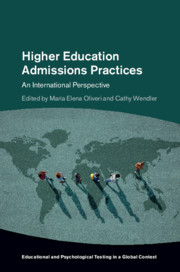Book contents
- Higher Education Admissions Practices
- Educational and Psychological Testing in a Global Context
- Higher Education Admissions Practices
- Copyright page
- Contents
- Figures
- Tables
- Contributors
- Series Editor’s Foreword
- Foreword
- Acknowledgments
- Part I Global Challenges and Common Admissions Models
- Part II Country-Specific Admissions Practices
- Chapter 7 Admissions Policies and Practices and the Reshaping of Access Patterns to Higher Education in Africa
- Chapter 8 Chile’s Admissions Tests: Pending Changes and Revisions
- Chapter 9 Issues of Perceived Fairness in Admissions Assessments in Small Countries: The Case of the Republic of Cyprus
- Chapter 10 Higher Education Admissions Practices in Israel
- Chapter 11 Access, Equity, and Admissions in South African Higher Education
- Chapter 12 Admissions Practices in Sweden
- Chapter 13 Revisions of Admissions Testing in Vietnam: From Elite to Mass Higher Education
- Part III Assessments Used in Higher Education Admissions
- Part IV Rethinking Higher Education Admissions
- Index
- References
Chapter 12 - Admissions Practices in Sweden
from Part II - Country-Specific Admissions Practices
Published online by Cambridge University Press: 09 January 2020
- Higher Education Admissions Practices
- Educational and Psychological Testing in a Global Context
- Higher Education Admissions Practices
- Copyright page
- Contents
- Figures
- Tables
- Contributors
- Series Editor’s Foreword
- Foreword
- Acknowledgments
- Part I Global Challenges and Common Admissions Models
- Part II Country-Specific Admissions Practices
- Chapter 7 Admissions Policies and Practices and the Reshaping of Access Patterns to Higher Education in Africa
- Chapter 8 Chile’s Admissions Tests: Pending Changes and Revisions
- Chapter 9 Issues of Perceived Fairness in Admissions Assessments in Small Countries: The Case of the Republic of Cyprus
- Chapter 10 Higher Education Admissions Practices in Israel
- Chapter 11 Access, Equity, and Admissions in South African Higher Education
- Chapter 12 Admissions Practices in Sweden
- Chapter 13 Revisions of Admissions Testing in Vietnam: From Elite to Mass Higher Education
- Part III Assessments Used in Higher Education Admissions
- Part IV Rethinking Higher Education Admissions
- Index
- References
Summary
This chapter describes the admission system to higher education in Sweden. It focuses on the instruments used in the selection –upper secondary grades and scores from the admissions test called the SweSAT. The Swedish educational system has a high degree of centralization. In addition, there is a strong belief in opportunities, lifelong learning, and second chances, all of which influence the educational system in numerous ways. The chapter first describes higher education institutions in Sweden and this is followed by discussions of admissions regulations and the selection criteria. Finally, various reform efforts are described.
- Type
- Chapter
- Information
- Higher Education Admissions PracticesAn International Perspective, pp. 203 - 216Publisher: Cambridge University PressPrint publication year: 2020
References
- 2
- Cited by



